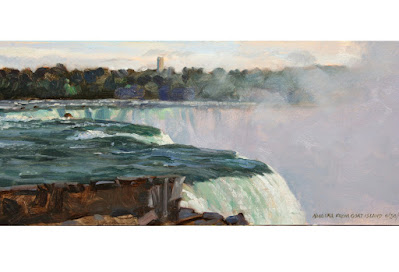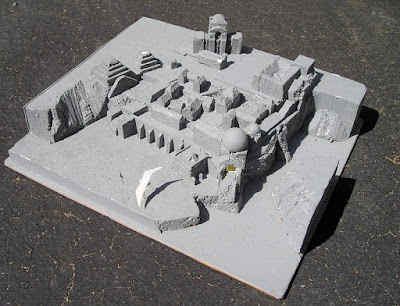A few days ago, in a previous post, I shared some of the preliminary sketches for the establishing shots of Waterfall City (below).
Waterfall City (1988), and Waterfall City: Afternoon Light (2002)
But there's only so much I can do from my imagination alone. To go beyond that, I have to "fill the bucket," which is what I call the process of gathering reference. One key step was painting at Niagara Falls.
I set up my painting gear on Goat Island with a bunch of kids watching. The studies help me understand how the water should look, something that's hard to get from photos.
The following clip is from a documentary I produced about the making of Dinotopia.
Here's the full production if you haven't seen it.
In a schematic maquette, you don’t have to sculpt every single building, just a few characteristic geometric forms. By looking at photos of those representative forms as you do your drawing, you can add details and multiply them into the full city.
The real benefit of such a schematic maquette is that you can swing it around at any angle and see how the light plays on it. This kind of model is a great help for entertainment designers or sequential artists who need to imagine a complex form consistently from a variety of angles.
I also built a more detailed maquette. This maquette is made from cardboard, styrofoam, and epoxy putty.
It helped me imagine perspective and lighting on this near corner of Waterfall City, which appeared from many angles in The World Beneath and Journey to Chandara.
After studying the maquettes, I draw a tone paper study and do a small oil sketch to solidify my vision of how the city will look veiled in mist.














7 comments:
In the photo showing you and all the school children watching on as you paint Niagara it appears you are using a French easel box. I am curious what moved you from that to your current homebrewed sketch easel. Was it just the weight, bulk, and portability? Or was it something else? Personally I love your homebrewed sketch easel, but it leaves me curious why you chose to go to the effort. What motivated the change?
On a separate note it is so much fun to see just a fraction of all the work and effort that went into creating the art and story of Dinotopia. It is a stark reminder that a project like this is not normally something you can splash onto canvas in one or two days and create with the level of detail and believability you obtained.
Definitely the magnificent result of a wall planned, original, masterfully creative and impressive act. -RQ
A titanic and wonderful work.
Thanks, Mr. Gurney for giving life to this unbelievable dream.
The sketches, maquettes, and model photos themselves would create a beautiful book.
Will it be another book on the series?
Thanks for sharing your dreams. Paulo - Rio
The maquette is beautiful - an object of delight in itself. If you were doing this today, would you, instead, do something in Sketch-Up or another electronic resource and skip the actual model-building?
Half of me says, why not? and the other half says, but then there would be no beautiful, hand-built one-of-a-kind object.
When you're allowed to travel again, I think you'd enjoy Jajce, Bosnia. It's a real-life waterfall city.
Post a Comment